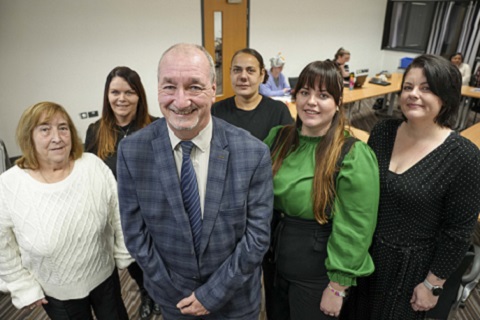Farmers in St Thomas have called for more work to be done in the sector to explore and take full advantage of the coconut palm’s (Cocos nucifera) versatile nature. Characterised as a “golden” plant by members of the Kanga Gully Farmers Group in Nutts River, the coconut tree and nut are said to have properties that can be used to make a variety of items that the industry has not yet tapped into.
The 26-member group was engaged in a training session held at Rainford Heslop’s Holdings where Danavan Pryce, an agronomist at Newport-Fersan Jamaica Limited, informed them of best practices to execute on their farms.
During Tuesday’s meeting, as he provided information on nutrition management, Pryce said the many factors that affect crops included the application rate of fertiliser, not knowing the potential of the crop being planted, and not applying the correct nutrients to the right kind of soil, all of which impact the crop’s output.
“Every plant needs at least 17 (macro and micro) nutrients to carry out their functions,” he said. Continuing, he said a plant’s development would be impacted if these nutrients were not provided at the right time, in appropriate amounts, and distributed in the proper locations.
He added that the pH of the soil was another factor that affected crops’ growth and that, for effective cultivation, a plot of land needed to maintain a 5.5 to 6.5 pH balance so that nutrients can be dissolved. “You can buy the best fertiliser but, if the soil too alkaline, the plant can’t take it up,” he said.
The traditional fertilisers used by farmers, such as 11-22-22, 14-28-14 and 15-5-35, he said, had a total of eight nutrients combined which resulted in farmers wasting money and their crops being left to suffer. “What we are realising is that the three little nutrients that farmers used to put on can’t carry the crop right through, so what we have to do is to develop blends that put more fertiliser in one bag ... making it more economical,” he said.
Pryce advised farmers to have their soil tested to learn what nutrients the soil was deficient in and to identify the kind of soil to understand how the crops might be impacted during the absorption process. Speaking on coconut production, Pryce stated that practices like fertilising the crop when the soil is dehydrated, which leads to a 70-per-cent loss of the fertiliser due to weather elements, resulted in farmers overspending on fertiliser.
Instead, farmers should break up the soil or dig a hole near the roots of the plant as this technique ensures that the nutrients penetrate the plant effectively. After the day’s lesson, the farmers laboured in the field to establish a coconut nursery on Rainford Heslop’s Holdings, planting 300 Maypan coconut seed nuts, sourced from Barton Isles, St Elizabeth, which has a high resistance to lethal yellowing and other diseases. The next time the group meets, they will be shown a demonstration on how to apply miticide using a mist blower.
Heading the nursery session was Desireina Delancy, coconut technician at the Caribbean Agricultural Research and Development Institute. The session is held under ‘The Alliances Coconut Industry Development, Expansion and Enhanced Support for the Caribbean’ project and funded by the European Union.
It is being executed by the CARDI in partnership with the Coconut Industry Board, International Trade Centre, the Rural Agricultural Development Authority (RADA) and other regional and national partners. “Over the years we have seen a need to expand the coconut industry,” Delancy said, indicating that one reason was because coconut is a huge part of the Caribbean region’s diet.
The project, which will impact more than 200 farmers, aims to identify priority areas in need of development across Hanover, Portland, St Mary, St Thomas and St Elizabeth, offering improved access to financing and employment, food security, increased availability of high-quality planting material, improved farming practices and access to extension services among other things.
She noted that a successful industry could only “stand the test of time”, through building the knowledge bank and passing on the relevant information to the upcoming generation. Four to six months after the seeds have germinated, farmers will be given some of them for free.
“Something that we really want to start encouraging farmers to do is to buy into the value-added products of coconut ... to start thinking ‘what else can I do with coconut’,” she said, referring to a farmer in the area who used the nut to make coir fibre. In the 1980s, Jamaica’s coconut industry was ravaged by the lethal yellowing disease which resulted in a decline in the amount of land used for coconut cultivation.
The members of the Kanga Gully Farmers Group in Nutts River, St Thomas, said the lethal yellowing had come extremely close to wiping out the entire population of the coconut industry in Jamaica, impacting parishes such as Portland and St Thomas. The Michael Black method, they said, was what helped the industry to recover, where farmers identified a tree that was infected and the area where the coconut bears was cut off and the stalk burned to eliminate chances of the disease further spreading.
“And [when] you plant another sucker right at the root of that one, strange enough, although the lethal yellowing kill that big bearing tree, that young tree that is coming will come up and bear,” farmer Adam Francis explained. Leslie Anderson stated that the training session at Rainford Heslop’s Holdings was beneficial because it also provided follow-up technical assistance. He expressed gratitude to CARDI for doing “a great job” in imparting information based on its conducted research.
“CARDI, what they impart to you is a win-win for the farmers,” he added. Sharing this sentiment, Francis, who is the secretary of the farmers group, stated that “coconut is always a win-win”, explaining that every portion of the coconut can be used to create by-products, such as fuel, sugar, coconut drink, cream and lumber.
Adding to the list of things derived from coconut, like coconut oil, Anderson stated that even toothpicks are a by-product. “Even the leaves, the strands from the leaves you can use it as a toothpick. You only want to clean them off properly, cut them to size and package it and you have a product right there ... but we are not utilising what we have,” he said.
He said all farmers should be assisted in having a small factory on their farm to facilitate value-added products “because the coconut farmer can do so much”. He added that, when a tree dies, it can also be chopped and used as lumber to make “one of the most beautiful pieces of furniture”.
The recovery of the sector, Anderson said, was dependent on how far this kind of outreach goes and how well it is taken up by other farmers.












